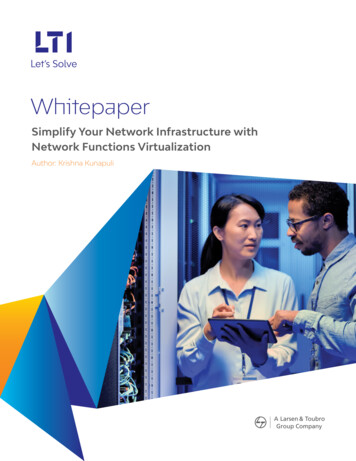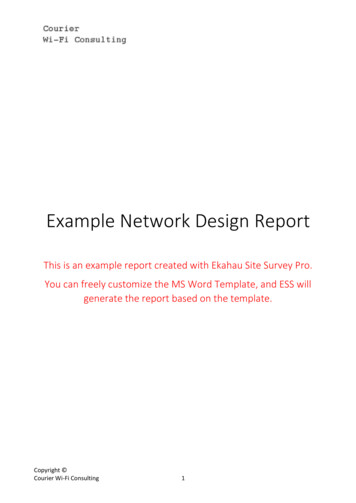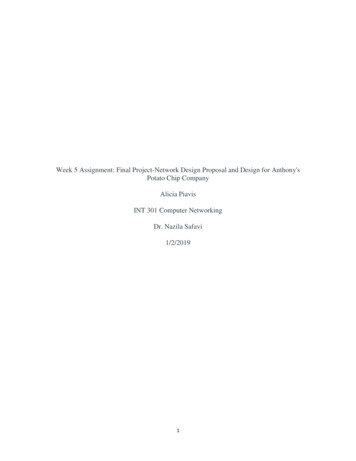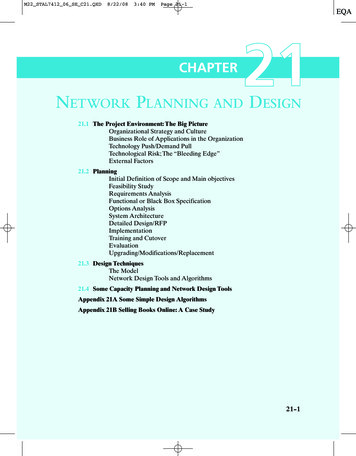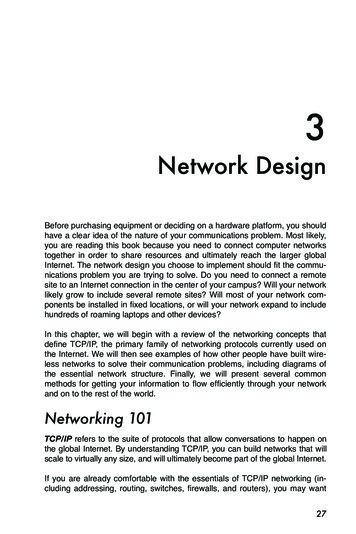
Transcription
3Network DesignBefore purchasing equipment or deciding on a hardware platform, you shouldhave a clear idea of the nature of your communications problem. Most likely,you are reading this book because you need to connect computer networkstogether in order to share resources and ultimately reach the larger globalInternet. The network design you choose to implement should fit the communications problem you are trying to solve. Do you need to connect a remotesite to an Internet connection in the center of your campus? Will your networklikely grow to include several remote sites? Will most of your network components be installed in fixed locations, or will your network expand to includehundreds of roaming laptops and other devices?In this chapter, we will begin with a review of the networking concepts thatdefine TCP/IP, the primary family of networking protocols currently used onthe Internet. We will then see examples of how other people have built wireless networks to solve their communication problems, including diagrams ofthe essential network structure. Finally, we will present several commonmethods for getting your information to flow efficiently through your networkand on to the rest of the world.Networking 101TCP/IP refers to the suite of protocols that allow conversations to happen onthe global Internet. By understanding TCP/IP, you can build networks that willscale to virtually any size, and will ultimately become part of the global Internet.If you are already comfortable with the essentials of TCP/IP networking (including addressing, routing, switches, firewalls, and routers), you may want27
28 Chapter 3: Network Designto skip ahead to Designing the Physical Network on Page 51. We will nowreview the basics of Internet networking.IntroductionVenice, Italy is a fantastic city to get lost in. The roads are mere foot pathsthat cross water in hundreds of places, and never go in a simple straight line.Postal carriers in Venice are some of the most highly trained in the world,specializing in delivery to only one or two of the six sestieri (districts) of Venice. This is necessary due to the intricate layout of that ancient city. Manypeople find that knowing the location of the water and the sun is far moreuseful than trying to find a street name on a map.Figure 3.1: Another kind of network mask.Imagine a tourist who happens to find papier-mâché mask as a souvenir, andwants to have it shipped from the studio in S. Polo, Venezia to an office inSeattle, USA. This may sound like an ordinary (or even trivial) task, but let'slook at what actually happens.The artist first packs the mask into a shipping box and addresses it to theoffice in Seattle, USA. They then hand this off to a postal employee, who attaches some official forms and sends it to a central package processing hubfor international destinations. After several days, the package clears Italiancustoms and finds its way onto a transatlantic flight, arriving at a central import processing location in the U.S. Once it clears through U.S. customs, thepackage is sent to the regional distribution point for the northwest U.S., thenon to the Seattle postal processing center. The package eventually makes itsway onto a delivery van which has a route that brings it to the proper address, on the proper street, in the proper neighborhood. A clerk at the office
Chapter 3: Network Design 29accepts the package and puts it in the proper incoming mail box. Once it arrives, the package is retrieved and the mask itself is finally received.The clerk at the office in Seattle neither knows nor cares about how to get tothe sestiere of S. Polo, Venezia. His job is simply to accept packages as theyarrive, and deliver them to the proper person. Similarly, the postal carrier inVenice has no need to worry about how to get to the correct neighborhood inSeattle. His job is to pick up packages from his local neighborhood and forward them to the next closest hub in the delivery chain.InternetRouterRouterImage.jpgPart 1 of 10ComputerImage.jpgPart 10 of 10ServerFigure 3.2: Internet networking. Packets are forwarded between routers until theyreach their ultimate destination.This is very similar to how Internet routing works. A message is split up intomany individual packets, and are labeled with their source and destination.The computer then sends these packets to a router, which decides where tosend them next. The router needs only to keep track of a handful of routes(for example, how to get to the local network, the best route to a few otherlocal networks, and one route to a gateway to the rest of the Internet). Thislist of possible routes is called the routing table. As packets arrive at therouter, the destination address is examined and compared against its internalrouting table. If the router has no explicit route to the destination in question,it sends the packet to the closest match it can find, which is often its ownInternet gateway (via the default route). And the next router does the same,and so forth, until the packet eventually arrives at its destination.Packages can only make their way through the international postal system because we have established a standardized addressing scheme for packages.For example, the destination address must be written legibly on the front of thepackage, and include all critical information (such as the recipient's name,
30 Chapter 3: Network Designstreet address, city, country, and postal code). Without this information, packages are either returned to the sender or are lost in the system.Packets can only flow through the global Internet because we have agreedon a common addressing scheme and protocol for forwarding packets.These standard communication protocols make it possible to exchange information on a global scale.Cooperative communicationsCommunication is only possible when the participants speak a common language. But once the communication becomes more complex than a simpleconversation between two people, protocol becomes just as important aslanguage. All of the people in an auditorium may speak English, but without aset of rules in place to establish who has the right to use the microphone, thecommunication of an individual s ideas to the entire room is nearly impossible. Now imagine an auditorium as big as the world, full of all of the computers that exist. Without a common set of communication protocols to regulatewhen and how each computer can speak, the Internet would be a chaoticmess where every machine tries to speak at once.People have developed a number of communications frameworks to addressthis problem. The most well-known of these is the OSI model.The OSI modelThe international standard for Open Systems Interconnection (OSI) is defined by the document ISO/IEC 7498-1, as outlined by the InternationalStandards Organization and the International Electrotechnical Commission.The full standard is available as publication "ISO/IEC 7498-1:1994," availablefrom ndards/.The OSI model divides network traffic into a number of layers. Each layer isindependent of the layers around it, and each builds on the services providedby the layer below while providing new services to the layer above. The abstraction between layers makes it easy to design elaborate and highly reliable protocol stacks, such as the ubiquitous TCP/IP stack. A protocol stackis an actual implementation of a layered communications framework. TheOSI model doesn't define the protocols to be used in a particular network, butsimply delegates each communications "job" to a single layer within a welldefined hierarchy.While the ISO/IEC 7498-1 specification details how layers should interactwith each other, it leaves the actual implementation details up to the manufacturer. Each layer can be implemented in hardware (more common forlower layers) or software. As long as the interface between layers adheres to
Chapter 3: Network Design 31the standard, implementers are free to use whatever means are available tobuild their protocol stack. This means that any given layer from manufacturerA can operate with the same layer from manufacturer B (assuming the relevant specifications are implemented and interpreted correctly).Here is a brief outline of the seven-layer OSI networking model:LayerNameDescription7ApplicationThe Application Layer is the layer that most network users are exposed to, and is the level at whichhuman communication happens. HTTP, FTP, andSMTP are all application layer protocols. The humansits above this layer, interacting with the application.6PresentationThe Presentation Layer deals with data representation, before it reaches the application. This wouldinclude MIME encoding, data compression, formatting checks, byte ordering, etc.5SessionThe Session Layer manages the logical communications session between applications. NetBIOS andRPC are two examples of a layer five protocol.4TransportThe Transport Layer provides a method of reachinga particular service on a given network node. Examples of protocols that operate at this layer are TCPand UDP. Some protocols at the transport layer(such as TCP) ensure that all of the data has arrivedat the destination, and is reassembled and deliveredto the next layer in the proper order. UDP is a "connectionless" protocol commonly used for video andaudio streaming.3NetworkIP (the Internet Protocol) is the most common Network Layer protocol. This is the layer where routingoccurs. Packets can leave the link local network andbe retransmitted on other networks. Routers performthis function on a network by having at least twonetwork interfaces, one on each of the networks tobe interconnected. Nodes on the Internet arereached by their globally unique IP address. Anothercritical Network Layer protocol is ICMP, which is aspecial protocol which provides various managementmessages needed for correct operation of IP. Thislayer is also sometimes referred to as the InternetLayer.
32 Chapter 3: Network DesignLayerNameDescription2Data LinkWhenever two or more nodes share the same physical medium (for example, several computers pluggedinto a hub, or a room full of wireless devices all usingthe same radio channel) they use the Data LinkLayer to communicate. Common examples of datalink protocols are Ethernet, Token Ring, ATM, andthe wireless networking protocols (802.11a/b/g).Communication on this layer is said to be link-local,since all nodes connected at this layer communicatewith each other directly. This layer is sometimesknown as the Media Access Control (MAC) layer.On networks modeled after Ethernet, nodes are referred to by their MAC address. This is a unique 48bit number assigned to every networking devicewhen it is manufactured.1PhysicalThe Physical Layer is the lowest layer in the OSImodel, and refers to the actual physical medium overwhich communications take place. This can be acopper CAT5 cable, a fiber optic bundle, radiowaves, or just about any other medium capable oftransmitting signals. Cut wires, broken fiber, and RFinterference are all physical layer problems.The layers in this model are numbered one through seven, with seven at thetop. This is meant to reinforce the idea that each layer builds upon, and depends upon, the layers below. Imagine the OSI model as a building, with thefoundation at layer one, the next layers as successive floors, and the roof atlayer seven. If you remove any single layer, the building will not stand. Similarly, if the fourth floor is on fire, then nobody can pass through it in eitherdirection.The first three layers (Physical, Data Link, and Network) all happen "on thenetwork." That is, activity at these layers is determined by the configuration ofcables, switches, routers, and similar devices. A network switch can only distribute packets by using MAC addresses, so it need only implement layersone and two. A simple router can route packets using only their IP addresses,so it need implement only layers one through three. A web server or a laptopcomputer runs applications, so it must implement all seven layers. Some advanced routers may implement layer four and above, to allow them to makedecisions based on the higher-level information content in a packet, such asthe name of a website, or the attachments of an email.The OSI model is internationally recognized, and is widely regarded as thecomplete and definitive network model. It provides a framework for manufac-
Chapter 3: Network Design 33turers and network protocol implementers that can be used to build networking devices that interoperate in just about any part of the world.From the perspective of a network engineer or troubleshooter, the OSI modelcan seem needlessly complex. In particular, people who build and troubleshoot TCP/IP networks rarely need to deal with problems at the Session orPresentation layers. For the majority of Internet network implementations, theOSI model can be simplified into a smaller collection of five layers.The TCP/IP modelUnlike the OSI model, the TCP/IP model is not an international standard andits definitions vary. Nevertheless, it is often used as a pragmatic model forunderstanding and troubleshooting Internet networks. The vast majority ofthe Internet uses TCP/IP, and so we can make some assumptions aboutnetworks that make them easier to understand. The TCP/IP model of networking describes the following five ta Link1PhysicalIn terms of the OSI model, layers five through seven are rolled into the topmost layer (the Application layer). The first four layers in both models areidentical. Many network engineers think of everything above layer four as"just data" that varies from application to application. Since the first three layers are interoperable between virtually all manufacturers' equipment, andlayer four works between all hosts using TCP/IP, and everything above layerfour tends to apply to specific applications, this s
Network Design Before purchasing equipment or deciding on a hardware platform, you should have a clear idea of the nature of your communications problem. Most likely, you are reading this book because you need to connect computer networks together in order to share resources and ultimately reach the larger global Internet. The network design you choose to implement should fit the commu .File Size: 968KBPage Count: 68


